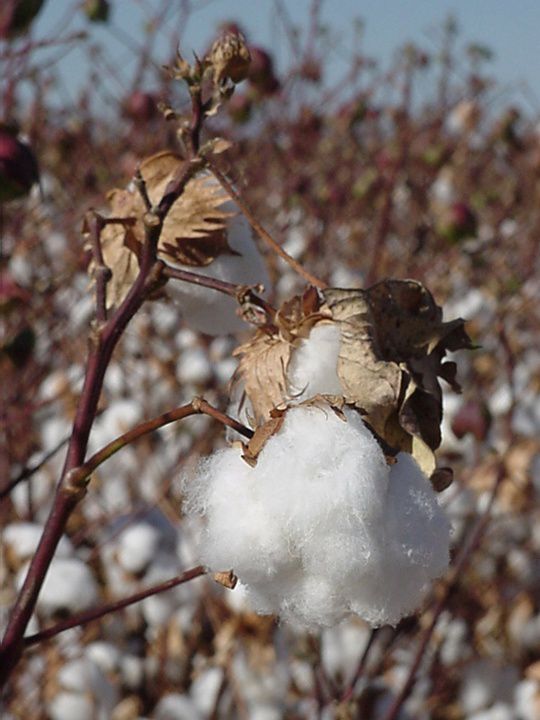Arizona Agriculture's Fun Cotton Facts
Published
12/12/2013
Topics:
By Julie Murphree, Arizona Farm Bureau: You won't find more facts about cotton in one place than right here. Arizona's cotton harvest for 2013 is pretty much complete. However, it's appropriate to celebrate this very important agriculture commodity year around!

To celebrate this wonderful Arizona agriculture crop that brings more than $500 million to our state, Arizona Farm Bureau provides you with an exhaustive list of fun cotton facts, 36 of them to be exact.
- The fiber from one 480-pound cotton bale can produce 215 pairs of jeans, 250 single bed sheets, 750 shirts, 1,200 t-shirts, 2,100 pairs of boxer shorts, 4,300 pairs of socks or 680,000 cotton balls.
- Cotton seeds are tough enough to survive travel across oceans on the wind. This could explain how botanists are not sure where the first cotton plants came from, and probably why similar varieties grow sometimes thousands of miles apart. But it does explain why the Hohokam Indian tribe was growing it thousands of years ago here in the southwest.
- Even though cotton is over 5,000 years old, the people who grew and used it never came in contact with each other. Some of them even lived on different sides of an ocean, but astonishingly enough, they still managed to develop similar tools to clean, prepare, spin, and weave it.
- Despite its well-earned reputation
of casual comfort, the actual word "cotton" is an English version of the Arabic "qutun " or "kutun ," a generic term meaning fancy fabric. One of cotton's original popular names was "vegetable wool." - Cotton was originally not only grown in
white, but assorted other colors including brown, rust and light purple. When mechanical processing methods (think the Industrial Age)were introduced it was easier to maintain color consistency by using only white-fibered plants. - Arizona cotton, along with California cotton, is some of the whitest, highest-quality cotton around. One main reason is that Arizona and California irrigate the cotton. With so little rainfall in the southwest, the cotton fiber is not at risk for compromised quality due to wind and rain.
- One of the finest extra-long staple (ELS)
cottons was developed and grown right here in Arizona. The USDA in Sacaton, Arizona, had an ELS breeding program that helped develop the ELS cotton. - It is in the same family as hibiscus, okra, and swamp mallow.
- The immature flower bud is called a square.
- The plant has been grown and used in India for at least 5000 years and probably for much longer.
- It was one of the earliest crops grown by European settlers, having been planted at the Jamestown colony in 1607.
- Planting time varies from the beginning of February in southern Texas to the beginning of June in the northern sections of the Cotton Belt.
- Cotton ranks just behind corn, soybeans, wheat, and hay among the leading cash crops
of United States agriculture and is among the nation's principal agricultural exports. - The leading cotton-producing states are Texas, California, Georgia, Mississippi, Arkansas, Louisiana, North Carolina, and Arizona.
- Some cotton products are padding in furniture and automobiles, cotton swabs, plastics, lacquers, smokeless powder for munitions, feed for cattle, cottonseed oil, yarn, cloth, cordage, and much more!
- American paper currency is made of 75% cotton.
- The first light bulb manufactured by Thomas Edison used
cotton filament. - Cotton is good for all seasons because it keeps the body cool in the summer and warm in the winter.
- The average American owns seven pairs of blue jeans.
- Ancient Egyptians grew cotton, but only the High Priest was allowed to wear a cotton garment.
- There are 150 yards of cotton in a regulation baseball.
- In 1730, cotton was first spun by machinery thanks to the Industrial Revolution.
- One bale of cotton weighs about 480 pounds.
- Levi Strauss and his partner added rivets into their denim jeans for added strength.
- Eli Whitney invented the cotton gin during the Industrial Revolution which changed the face of the cotton industry forever.
- Almost all parts of the cotton plant are used in some way, including the cottonseed, lint (raw cotton fiber), stalk and hull (shell). For example, popular uses for cotton fiber include clothing apparel such as denim jeans, socks, towels, t-shirts, bed sheets and underwear, home furnishings and industrial/medical products such as tents, bandages and cotton swabs.
- There is more cotton grown globally than any other non-edible crop.
- Since 1940, world cotton consumption has increased at an average annual growth rate of approximately 2%.
- Cotton fiber can be woven or knitted into fabrics such as velvet, corduroy, chambray, velour,
jersey and flannel. - Linters are the very short fibers that remain on the cottonseed after ginning. Once removed and processed,
linters are used to produce goods such as bandages, cotton buds, and x-rays. - Cottonseed oil can
used for cooking or used in a range of industrial products such as soap, margarine, emulsifiers, cosmetics, pharmaceuticals,rubber and plastics. - Cottonseed oil is cholesterol-free, high in
poly-unsaturated fats and contains high levels of antioxidants (Vitamin E) that contribute to its long shelf life. - The stalk of the cotton plant is processed for the development of ethanol in gasoline or diesel blends and also used as
mulch to improve soil organic matter. - Cotton is hypoallergenic since it doesn’t irritate sensitive skin or cause allergies.
- Cotton is one of the easiest fabrics to dye, making it very popular with fashion and
home ware designers. - The Cotton Belt spans 17 states in the United States all in the lower half of the country.